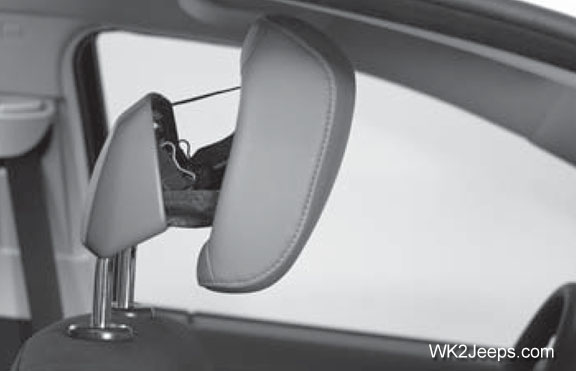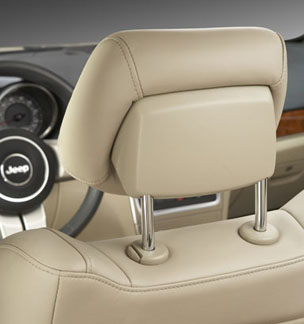WARNING:
All occupants, including the driver, should not operate a vehicle or sit in a vehicle’s seat until the head restraints are placed in their proper positions in order to minimize the risk of neck injury in the event of a collision. Do not place items over the top of the Active Head Restraint, such as coats, seat covers or portable DVD players. These items may interfere with the operation of the Active Head Restraint in the event of a collision and could result in serious injury or death.
Active Head Restraints may be deployed if they are struck by an object such as a hand, foot or loose cargo. To avoid accidental deployment of the Active Head Restraint, ensure that all cargo is secured, as loose cargo could contact the Active Head Restraint during sudden stops. Failure to follow this warning could cause personal injury if the Active Head Restraint is deployed.
AHR COMPONENTS
Active head restraints are those which require the vehicle occupants to take some action to initiate, such as electronic stability control. A passive system does not require any action by the vehicle occupants to operate. It simply activates when a set of criteria or sequence of events occur.
While the new Active Head Restraints (AHR) are passive in operation, they are referred to as an active system. The AHR system is designed to deploy in the event of a rear collision with the gear selector in any gear except Reverse. The AHR system is standard equipment for both front seats on the 2011-up Grand Cherokees.
The AHR system has a linkage permitting the lower part of the pad to tilt forward for comfort. It also includes a linkage that articulates the pad during deployment, a caliper-type latch mechanism, and the latch striker.
The only electrical component of the AHR unit is a latch-release solenoid and the pigtail wire that connects the solenoid to the vehicle’s electrical system. The ORC does not monitor the latch for an open or closed position. The pigtail wire and connector are routed through the center of the right support posts and down through the guide sleeve into the interior of the seat back. The pigtail wire and connector are connected to a dedicated takeout and connector of the seat wire harness.
AHR CONSTRUCTION
An AHR is readily distinguished from a non-active head restraint by the two-piece construction used for an AHR. The front half assembly consists of a molded reinforced plastic form covered with a foam pad and is trimmed in a material coordinated with the other soft trim on the seat. The rear half surface is equipped with a hard moulded plastic trim cover that matches the other hard trim on the seat. Located between the pad and the trim cover is the support structure of the AHR and both the mechanical and electrical components of the unit.
The support posts for the AHR units feature numerous notches that engage spring-loaded pins into detents located on the support post. The spring mechanism is integral to the plastic guide sleeves. These sleeves are used for manually adjusting the vertical height of the assembly to properly fit the seat occupant.
The front half of the head restraint extends forward to utilize the gap between the back of the occupant’s head and the head restraint. The system is designed to help prevent or reduce the extent of injuries to the driver and front passenger in certain types of rear impacts.
OCCUPANT RESTRAINT CONTROLLER
The ORC monitors the condition of the AHR unit circuits. It illuminates the air bag indicator in the Cabin Compartment Node (CCN) and stores a DTC for any detected fault. There is no air bag light illumination if only the AHR is deployed.
Unlike other components of the restraint system, the ORC supplies power to the actuators to activate the AHR system. The ORC monitors inputs from the front impact sensors and its internal accelerometer. It also monitors electronic message inputs received over the Controller Area Network (CAN) data bus to determine when the conditions exist to deploy both AHR units.
When the ORC sends the proper electrical deployment signal to the solenoid of the AHR unit, the solenoid releases the AHR latch. When the AHR latch is released, the tension of the spring-loaded linkage within the AHR mechanically drives the AHR pad forward. If at any point the AHR comes in contact with the occupant’s head, it stops the forward movement and locks to hold the head.
AHR DEPLOYMENT / RESETTING / SERVICE
If the Active Head Restraints are triggered during a collision, the front half of the head restraint will be extended forward and separated from the rear half of the head restraint. Do not drive your vehicle after the AHRs have deployed. The head restraint must be reset into the original position to best protect the occupant for all types of collisions. An authorized FCA US LLC dealer must reset the AHRs on the driver’s and front passenger’s seat before driving. Personally attempting to reset the AHRs may result in damage to the AHRs that could impair their function.
AHR OPERATION
The Active Head Restraint (AHR) units are deployed by a signal generated by the Occupant Restraint Controller (ORC) through the first row right and left solenoid and ground signal circuits. The ORC logic monitors inputs from the front impact sensors as well as electronic message inputs received over the Controller Area Network (CAN) data bus to determine when the appropriate conditions exist to send a deployment signal to both AHR units. When the ORC detects an impact pulse of sufficient magnitude originating from the rear of the vehicle, while any transmission gear is selected except Reverse (R), the ORC sends the deployment signals.
When the ORC sends the proper electrical deployment signal to the solenoid of the AHR unit, the solenoid releases the AHR latch. When the AHR latch is released, the tension of the spring-loaded linkage within the AHR mechanically drives the AHR pad through a short, slightly forward and upward arc to the final deployed position. Deployment of the AHR reduces the space between the back of the head of the seat occupant and the head restraint pad. Closing this space supports the head of the seat occupant during a low speed rear impact collision event and is important in reducing or eliminating potentially debilitating cervical (also known as whiplash) injuries.
The ORC monitors the condition of the AHR unit circuits, and will illuminate the airbag indicator in the ElectroMechanical Instrument Cluster (EMIC) (also known as the Cab Compartment Node/CCN) and store a Diagnostic Trouble Code (DTC) for any fault that is detected.
The hard wired circuits between the AHR units and the ORC may be diagnosed using conventional diagnostic tools and procedures. Refer to the appropriate wiring information. However, conventional diagnostic methods will not prove conclusive in the diagnosis of the AHR units or the electronic controls or communication between other modules and devices that provide some features of the Supplemental Restraint System (SRS). The most reliable, efficient, and accurate means to diagnose the AHR units or the electronic controls and communication related to AHR unit operation requires the use of a diagnostic scan tool. Refer to the appropriate diagnostic information.

